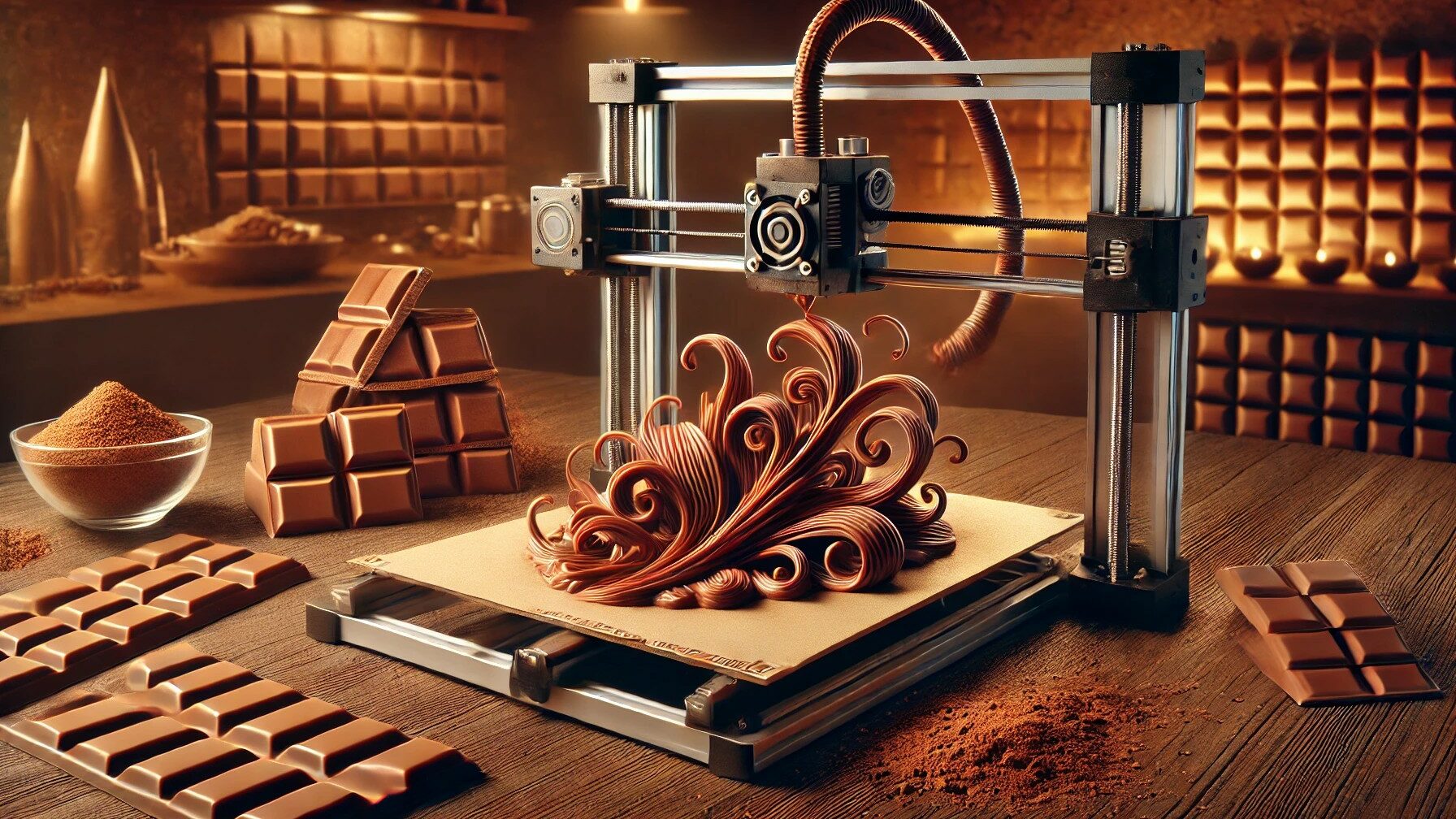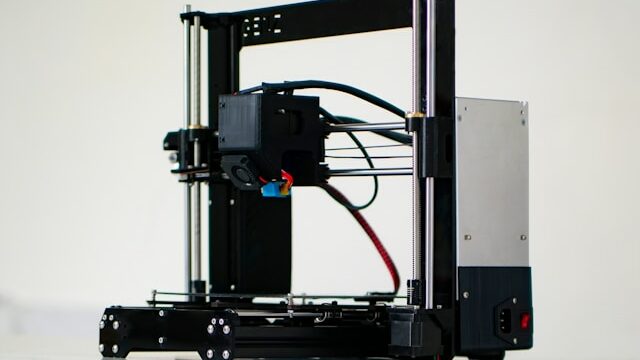Are you interested in 3D printing in chocolate? At Imprimy.com, we are here to answer all your questions.

What is 3D printing in chocolate?
3D printing in chocolate uses 3D printing technology to create chocolate objects instead of plastic filaments or traditional resin.
The definition of 3D printing applied to chocolate
3D printing in chocolate is an innovative technology that uses 3D printers to create edible objects from chocolate. This process involves layer-by-layer deposition of melted chocolate, following a digital model, to form complex and customized three-dimensional structures.
This method allows pastry chefs and cooks to create unique desserts with unmatched precision and creativity, while optimizing the use of raw materials and reducing waste.
The process of 3D chocolate printing
The process of 3D chocolate printing relies on a precise technological method. First, a 3D digital model is created using Computer-Aided Design (CAD) software. This model is then transmitted to a 3D printer specifically designed to handle food materials.
The printer heats the chocolate to a controlled temperature to make it fluid, then deposits it layer by layer onto a platform, following the instructions of the digital model. Each layer solidifies quickly, allowing the gradual construction of the desired three-dimensional structure. This process enables the creation of complex and detailed shapes, offering great creative freedom to pastry chefs and chefs.
A brief history of 3D chocolate printing
The history of 3D chocolate printing is relatively recent but fascinating. The first experiments with 3D food printing began in the early 2000s, but it wasn’t until the end of that decade that 3D chocolate printing truly emerged. In 2007, researchers from the University of Exeter in the UK were among the first to explore this technology, using 3D printers to create chocolate structures.
In 2011, the Dutch company byFlow launched one of the first 3D food printers capable of working with chocolate, paving the way for wider adoption in the food industry. Since then, several companies and startups have developed similar technologies, enabling chefs and pastry chefs to explore new creative dimensions with chocolate.
This rapid evolution has been supported by technological advancements and a growing demand for innovative culinary experiences, making 3D chocolate printing a promising trend in the field of modern gastronomy.
What are the advantages of 3D chocolate printing?
Among the various advantages of 3D chocolate printing, we can list customization of 3D prints, culinary innovations, waste reduction, and its application in the food industry.
The customization made possible by 3D chocolate printing
Customization is one of the main advantages of 3D chocolate printing. This technology allows pastry chefs and chefs to create unique and tailored desserts, meeting the specific demands of their clients. Thanks to the precision of 3D printers, it is possible to create complex and detailed shapes that would be difficult, if not impossible, to achieve with traditional methods.
This customization ability paves the way for innovative creations for special events such as weddings, birthdays, or parties, where each piece can be designed to reflect a particular theme or preference. Moreover, 3D printing makes it easy to adjust recipes and designs, offering unmatched flexibility to experiment with new ideas and satisfy the diverse tastes of consumers.
Culinary innovations associated with 3D chocolate printing
3D chocolate printing is revolutionizing the culinary world by introducing innovations that push the boundaries of creativity and precision. This technology allows chefs and pastry chefs to design desserts with complex shapes and varied textures, which would be impossible to achieve using traditional methods. Chefs can integrate architectural elements into their creations, playing with heights and volumes to surprise guests.
3D printing also enables the combination of different types of chocolate within the same piece, creating contrasts in flavors and textures. Pastry chefs can experiment with additional ingredients, such as dried fruits or spices, directly incorporated into the printing process to enhance the tasting experience.
This technology fosters interdisciplinary collaboration, bringing together designers, engineers, and chefs to push the limits of culinary creation. Restaurants and gastronomic events can offer unique experiences, where each plate becomes an edible work of art, captivating the imagination of customers and elevating pastry to a higher artistic level.
Efficiency and waste reduction related to 3D chocolate printing
3D chocolate printing offers significant advantages in terms of efficiency and waste reduction, contributing to a more sustainable production process. Thanks to this technology, pastry chefs can use the exact amount of chocolate needed for each creation, minimizing the waste of raw materials. The printing process deposits chocolate layer by layer, reducing losses compared to traditional methods, where excess can often be inevitable.
Moreover, 3D printing allows for the recycling of unused chocolate scraps by reintegrating them into the production process. This ability to reuse materials contributes to a more responsible management of resources.
Applications of 3D chocolate printing in the food industry
3D chocolate printing has numerous promising applications in the food industry, opening new possibilities for professionals and businesses. Here are some concrete examples:
- Fine Dining: Gastronomic restaurants can use this technology to create unique and sophisticated desserts, offering customers a memorable culinary experience. Each piece can be customized to match the preferences or special events of the customers.
- Events and Catering: For weddings, birthdays, or corporate events, 3D printing allows for the creation of custom chocolate designs, such as table centerpieces or personalized gifts, adding a touch of originality and elegance.
- Customized Mass Production: Food companies can integrate 3D printing into their production lines to offer customized products on a large scale, meeting the growing consumer demand for unique products.
- Prototyping and Product Development: Pastry chefs and chefs can use 3D printing to quickly test new ideas and concepts, accelerating the development of new products without excessive waste of raw materials.
- Education and Training: Culinary schools and training centers can incorporate 3D chocolate printing into their programs to teach students modern pastry techniques and inspire their creativity.
- Marketing and Branding: Brands can use 3D printing to create innovative marketing campaigns, producing chocolates with their logo or specific messages, thereby strengthening their visibility and engagement with consumers.
These applications highlight how 3D chocolate printing can transform the food industry, combining technological innovation and culinary creativity to offer unique experiences to consumers.
What are the challenges and limitations of 3D chocolate printing?
3D chocolate printing faces several challenges related to technical specifications, costs, food regulations, and more.
The technical complexity of 3D chocolate printing
3D chocolate printing presents several technical challenges that require expertise and particular attention to overcome. Here are some of the main technical complexities associated with this technology:
- Temperature management: The chocolate must be maintained at a precise temperature to remain fluid and homogeneous during printing. A temperature that is too high can burn the chocolate, while a temperature that is too low can cause blockages in the printer.
- Viscosity and consistency: The consistency of the chocolate must be carefully controlled to allow for regular extrusion through the printer nozzle. Variations in viscosity can affect the precision and quality of the print.
- Printer calibration: 3D printers need to be precisely calibrated to ensure that each layer of chocolate is deposited correctly. Poor calibration can result in distortions or imperfections in the final product.
- Materials and ingredients: The choice of chocolate and additional ingredients is crucial. Some types of chocolate may not be suitable for 3D printing due to their composition or thermal behavior.
- Solidification time: The chocolate needs to solidify quickly after printing to maintain the desired shape, but not too quickly to avoid cracks or irregularities. This process requires a delicate balance.
- Maintenance and cleaning: Food 3D printers require regular maintenance to ensure optimal performance and compliance with food hygiene standards. Cleaning the nozzles and chocolate reservoirs can be tedious.
- Regulatory compliance: The use of 3D printing in chocolate in a commercial environment must adhere to existing food regulations, which can add another layer of complexity to the production process.
These technical challenges require a deep understanding of the properties of chocolate and 3D printing technologies, as well as constant attention to detail to ensure high-quality results.
The cost of 3D chocolate printing
The cost of 3D chocolate printing can vary significantly depending on several factors, making this technology primarily accessible to professionals and businesses with a substantial budget. Here are some elements that influence the cost:
- Initial investment: Purchasing a 3D food printer represents a significant investment. Machines specialized in chocolate printing can cost several thousand euros, depending on their capacity and features.
- Raw material costs: The chocolate used for 3D printing must be of high quality to ensure good results. The cost of ingredients can therefore be high, especially if premium chocolates or additional ingredients are used.
- Maintenance and upkeep: 3D printers require regular maintenance to function properly. Maintenance costs, including cleaning and part replacements, should be considered.
- Training and expertise: Efficient use of 3D chocolate printing requires specialized training. Companies may need to invest in training their staff or hire experts to optimize the process.
- Development and prototyping: Developing new products or designs may require several trials, which increases costs in terms of time and materials.
- Regulatory compliance: Adhering to hygiene and food safety standards can also lead to additional costs, particularly for equipment and process certification.
Despite these costs, 3D chocolate printing offers significant advantages in terms of customization and innovation, which may justify the investment for businesses seeking to stand out in the market.
Food regulations applying to 3D chocolate printing
3D chocolate printing, like any other food technology, must comply with strict regulations to ensure the safety and quality of the finished products. Here are some of the main food regulations that apply:
- Food hygiene and safety: 3D printers used for chocolate must be designed and maintained according to food hygiene standards. This includes regular cleaning of the equipment and using materials that are compatible with food.
- Traceability of ingredients: All ingredients used in the 3D printing process must be traceable, allowing the identification of their source in case of a food safety issue.
- Material compliance: Materials in contact with food, such as nozzles and reservoirs of the printer, must be certified for food use and must not contaminate the chocolate.
- Labeling and consumer information: 3D printed products must be properly labeled, indicating ingredients, potential allergens, and nutritional information.
- Quality control: Quality control procedures must be in place to verify the consistency and safety of the finished products. This may include microbiological testing and composition analysis.
- Local and international regulations: Companies must comply with local regulations as well as international standards if they export their products. For example, in Europe, products must comply with European Union food safety regulations.
- Staff training: Personnel handling 3D printers and ingredients must be trained in good hygiene practices and food handling procedures.
Adhering to these regulations is essential to ensure that 3D printed products are safe for consumption and meet consumer expectations for quality and food safety.
The sustainability of 3D chocolate printing
The sustainability of 3D chocolate printing is a crucial aspect for businesses looking to adopt this technology. Here are some key points concerning sustainability:
- Waste reduction: 3D printing allows only the exact amount of chocolate needed for each creation, minimizing the waste of raw materials. Chocolate residues can also be recycled and reintegrated into the production process.
- Resource optimization: By producing custom pieces, 3D printing avoids overproduction and excess stock, contributing to a more efficient management of resources.
- Energy and efficiency: While 3D printers consume energy, their use can be optimized to reduce the overall carbon footprint, particularly by producing locally and avoiding long-distance transportation.
- Sustainable materials: Using chocolates sourced from sustainable and certified origins (such as fair trade or organic labels) can enhance the environmental and social commitment of businesses.
- Innovation and research: Technological advances in food 3D printing may lead to even more sustainable solutions, such as the use of alternative materials or improvements in production processes.
- Education and awareness: By integrating sustainable practices into the 3D printing process, businesses can raise consumer awareness about the importance of sustainability in the food industry.
By adopting a sustainable approach, businesses can not only reduce their environmental impact but also meet the growing consumer demand for ecological responsibility.
What is the future of 3D chocolate printing?
The future of 3D chocolate printing lies in new trends, the evolution of research and development, and its impact on the chocolate market.
Future trends in 3D chocolate printing
The future trends in 3D chocolate printing include innovation in manufacturing techniques, allowing for increased customization of chocolate products. The integration of artificial intelligence and automation could optimize production processes, while the use of sustainable and eco-friendly materials will address environmental concerns.
Additionally, the exploration of new textures and flavors through innovative ingredients could revolutionize the chocolate industry, offering consumers unique and unprecedented taste experiences.
Research and development related to 3D chocolate printing
Research and development related to 3D chocolate printing focuses on improving manufacturing techniques to achieve high-quality products with increased precision and repeatability. Researchers are exploring new chocolate formulations tailored for 3D printing, while integrating advanced technologies such as artificial intelligence to optimize recipes and processes.
Additionally, efforts are being made to develop specialized 3D printers capable of handling the unique properties of chocolate, such as its melting temperature and viscosity. Finally, the focus is on sustainable innovation, with the use of environmentally friendly materials and the reduction of waste in the production process.
The impact of 3D printing on the chocolate market
The impact of 3D printing on the chocolate market is significant, opening new perspectives for product customization and design innovation. This technology allows chocolatiers to create complex and unique shapes, which are difficult to achieve with traditional methods, thus attracting customers seeking original taste experiences.
Additionally, 3D printing encourages on-demand production, reducing inventory and waste, which can enhance operational efficiency and sustainability. By integrating functional ingredients and varied textures, 3D chocolate printing can also address emerging food trends, driving growth and differentiation in a competitive market.
Conclusion : 3D Printing in Chocolate
In conclusion, 3D chocolate printing represents a transformative technology in the chocolate industry, offering significant benefits in terms of customization, innovation, and sustainability. By enabling chocolatiers to create intricate, personalized designs and textures, it opens up new creative possibilities that were previously unattainable with traditional methods. Furthermore, its potential for on-demand production reduces waste and improves operational efficiency, contributing to more sustainable practices.
As research and development continue to advance, the future of 3D chocolate printing holds promise for even more innovative and eco-friendly solutions. With the ability to meet emerging consumer trends and offer unique, memorable experiences, this technology is poised to redefine the way chocolate is crafted and enjoyed, making it an exciting area of growth for the industry.
Image generated by DALL·E, an artificial intelligence model developed by OpenAI.
The articles published on Imprimy.com are for informational purposes only. They are intended to provide general advice and information related to 3D printing. Imprimy.com cannot be held responsible for the results obtained or the consequences arising from the application of the shared information. We recommend always checking the specific instructions for your hardware and materials before use.


